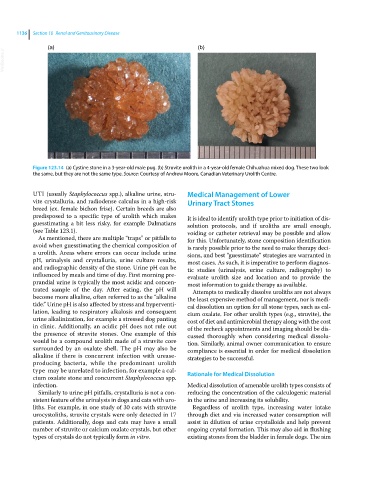Page 1198 - Clinical Small Animal Internal Medicine
P. 1198
1136 Section 10 Renal and Genitourinary Disease
(a) (b)
VetBooks.ir
Figure 123.14 (a) Cystine stone in a 3‐year‐old male pug. (b) Struvite urolith in a 4‐year‐old female Chihuahua mixed dog. These two look
the same, but they are not the same type. Source: Courtesy of Andrew Moore, Canadian Veterinary Urolith Centre.
UTI (usually Staphylococcus spp.), alkaline urine, stru Medical Management of Lower
vite crystalluria, and radiodense calculus in a high‐risk Urinary Tract Stones
breed (ex. female bichon frise). Certain breeds are also
predisposed to a specific type of urolith which makes It is ideal to identify urolith type prior to initiation of dis
guesstimating a bit less risky, for example Dalmatians solution protocols, and if uroliths are small enough,
(see Table 123.1). voiding or catheter retrieval may be possible and allow
As mentioned, there are multiple “traps” or pitfalls to for this. Unfortunately, stone composition identification
avoid when guesstimating the chemical composition of is rarely possible prior to the need to make therapy deci
a urolith. Areas where errors can occur include urine sions, and best “guesstimate” strategies are warranted in
pH, urinalysis and crystalluria, urine culture results, most cases. As such, it is imperative to perform diagnos
and radiographic density of the stone. Urine pH can be tic studies (urinalysis, urine culture, radiography) to
influenced by meals and time of day. First morning pre evaluate urolith size and location and to provide the
prandial urine is typically the most acidic and concen most information to guide therapy as available.
trated sample of the day. After eating, the pH will Attempts to medically dissolve uroliths are not always
become more alkaline, often referred to as the “alkaline the least expensive method of management, nor is medi
tide.” Urine pH is also affected by stress and hyperventi cal dissolution an option for all stone types, such as cal
lation, leading to respiratory alkalosis and consequent cium oxalate. For other urolith types (e.g., struvite), the
urine alkalinization, for example a stressed dog panting cost of diet and antimicrobial therapy along with the cost
in clinic. Additionally, an acidic pH does not rule out of the recheck appointments and imaging should be dis
the presence of struvite stones. One example of this cussed thoroughly when considering medical dissolu
would be a compound urolith made of a struvite core tion. Similarly, animal owner communication to ensure
surrounded by an oxalate shell. The pH may also be compliance is essential in order for medical dissolution
alkaline if there is concurrent infection with urease‐ strategies to be successful.
producing bacteria, while the predominant urolith
type may be unrelated to infection, for example a cal Rationale for Medical Dissolution
cium oxalate stone and concurrent Staphylococcus spp.
infection. Medical dissolution of amenable urolith types consists of
Similarly to urine pH pitfalls, crystalluria is not a con reducing the concentration of the calculogenic material
sistent feature of the urinalysis in dogs and cats with uro in the urine and increasing its solubility.
liths. For example, in one study of 30 cats with struvite Regardless of urolith type, increasing water intake
urocystoliths, struvite crystals were only detected in 17 through diet and via increased water consumption will
patients. Additionally, dogs and cats may have a small assist in dilution of urine crystalloids and help prevent
number of struvite or calcium oxalate crystals, but other ongoing crystal formation. This may also aid in flushing
types of crystals do not typically form in vitro. existing stones from the bladder in female dogs. The aim

